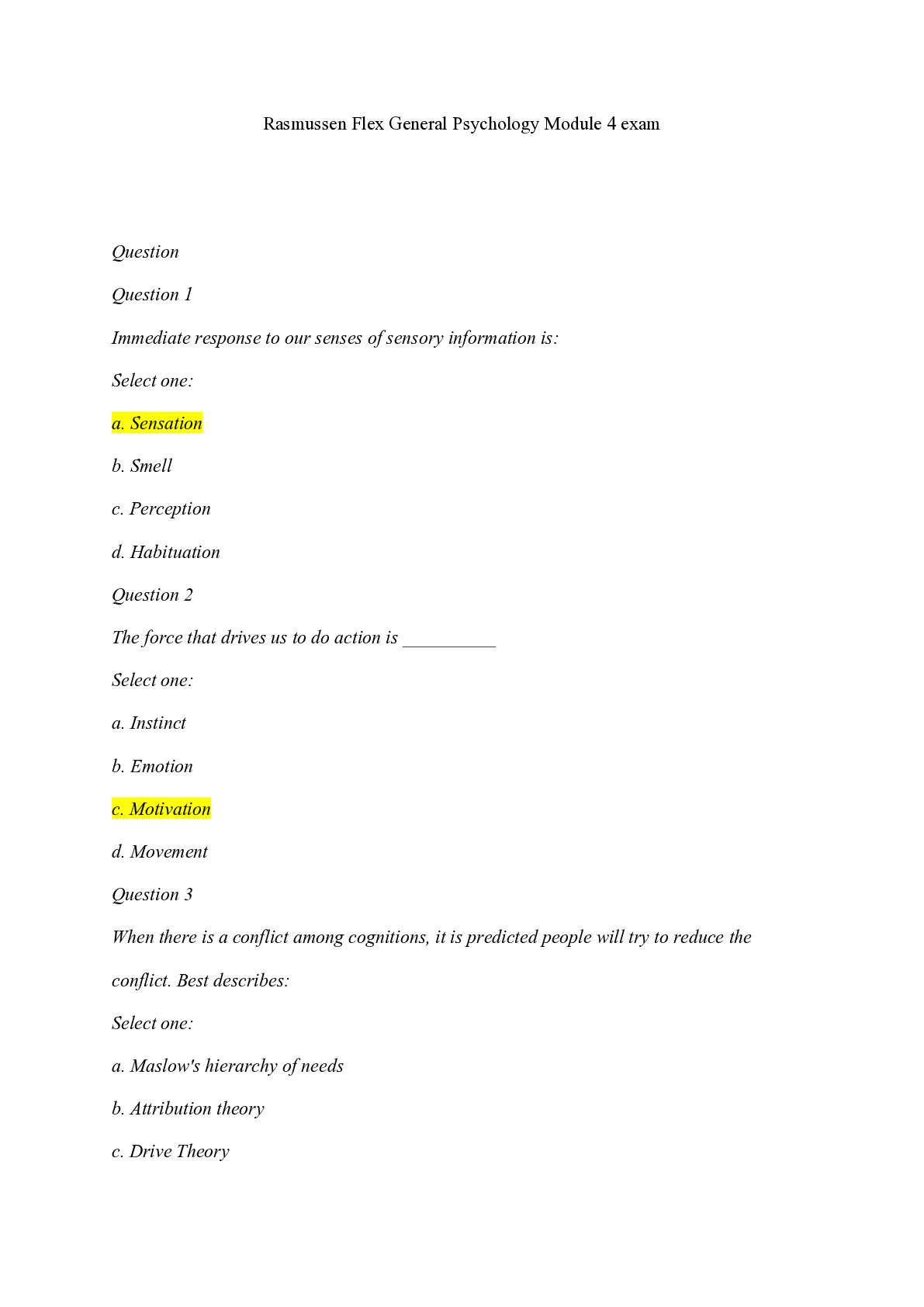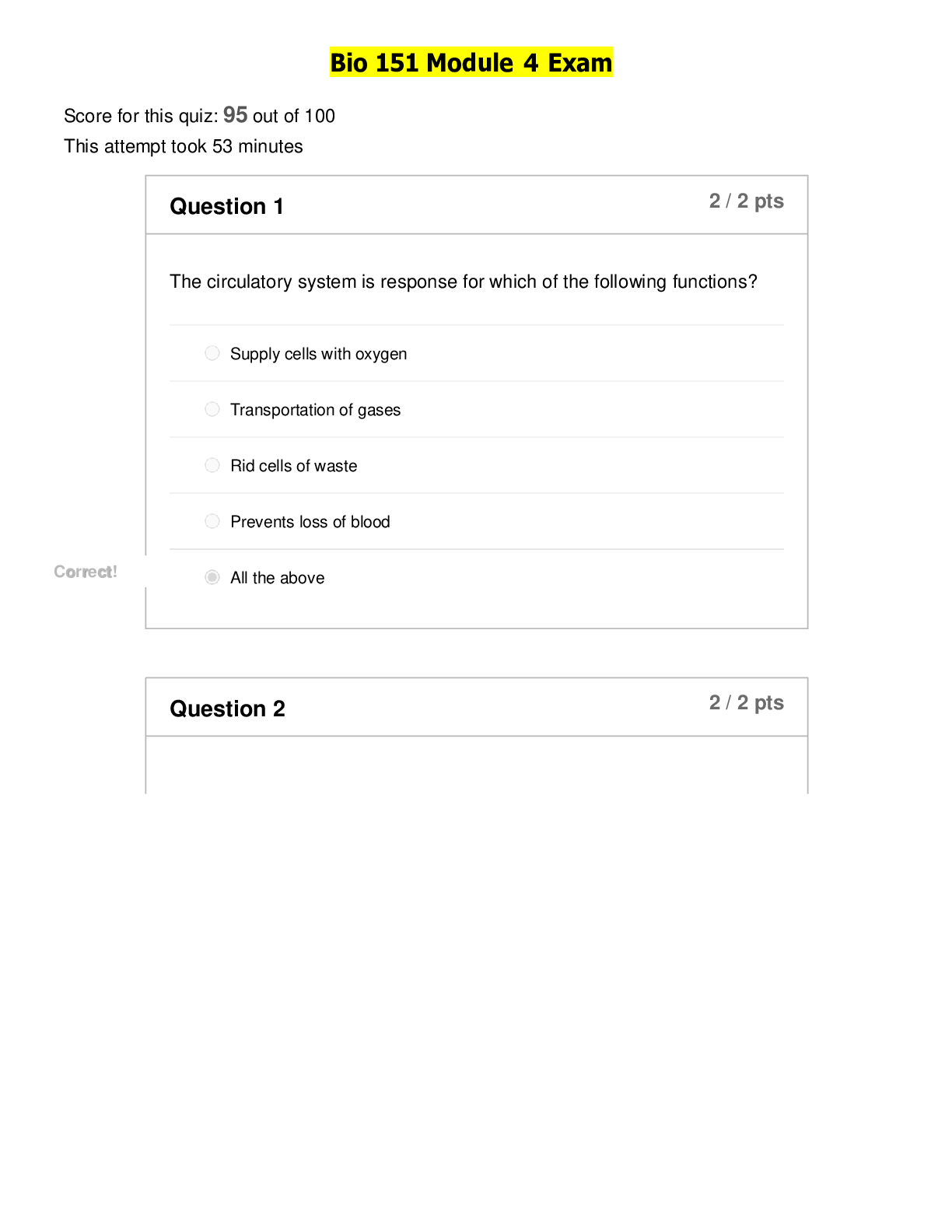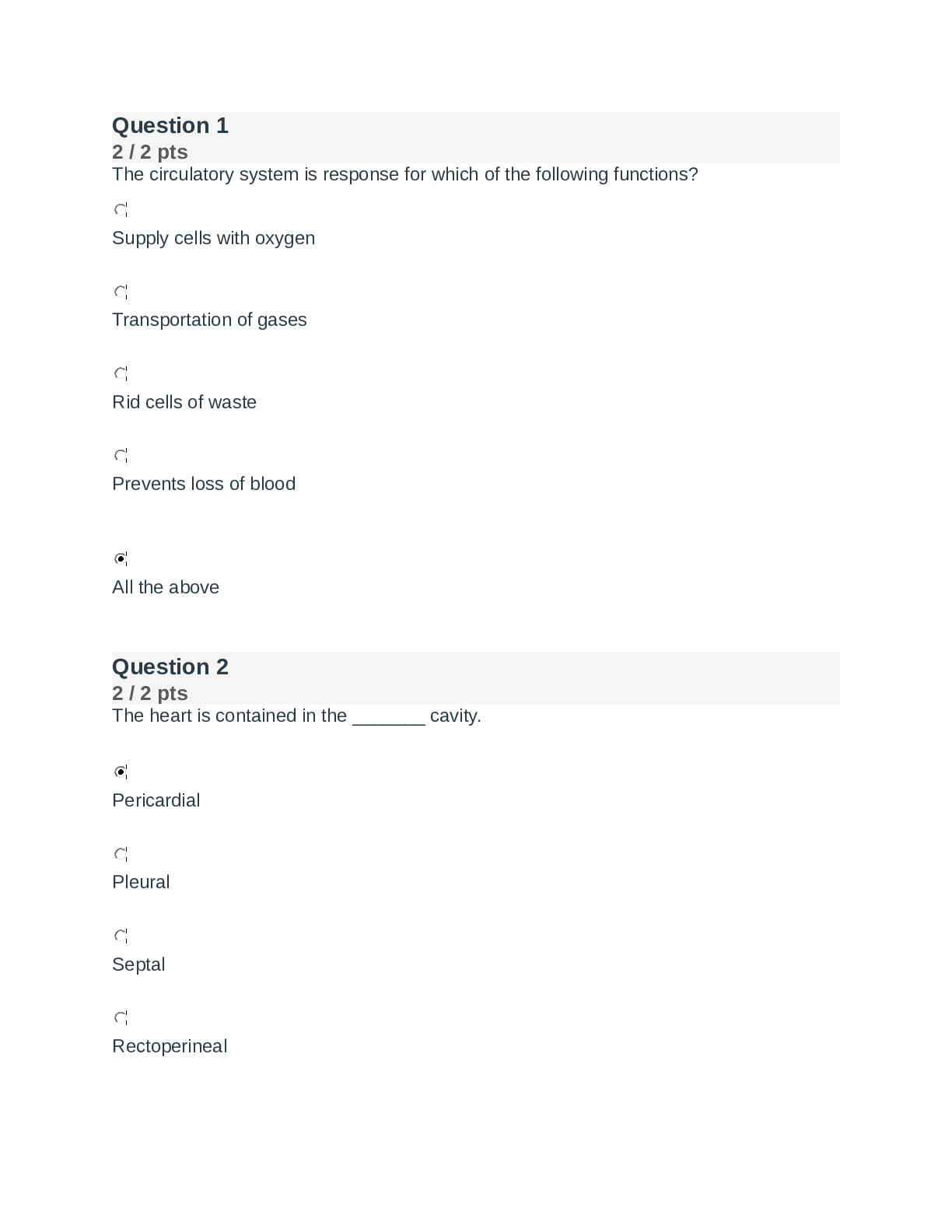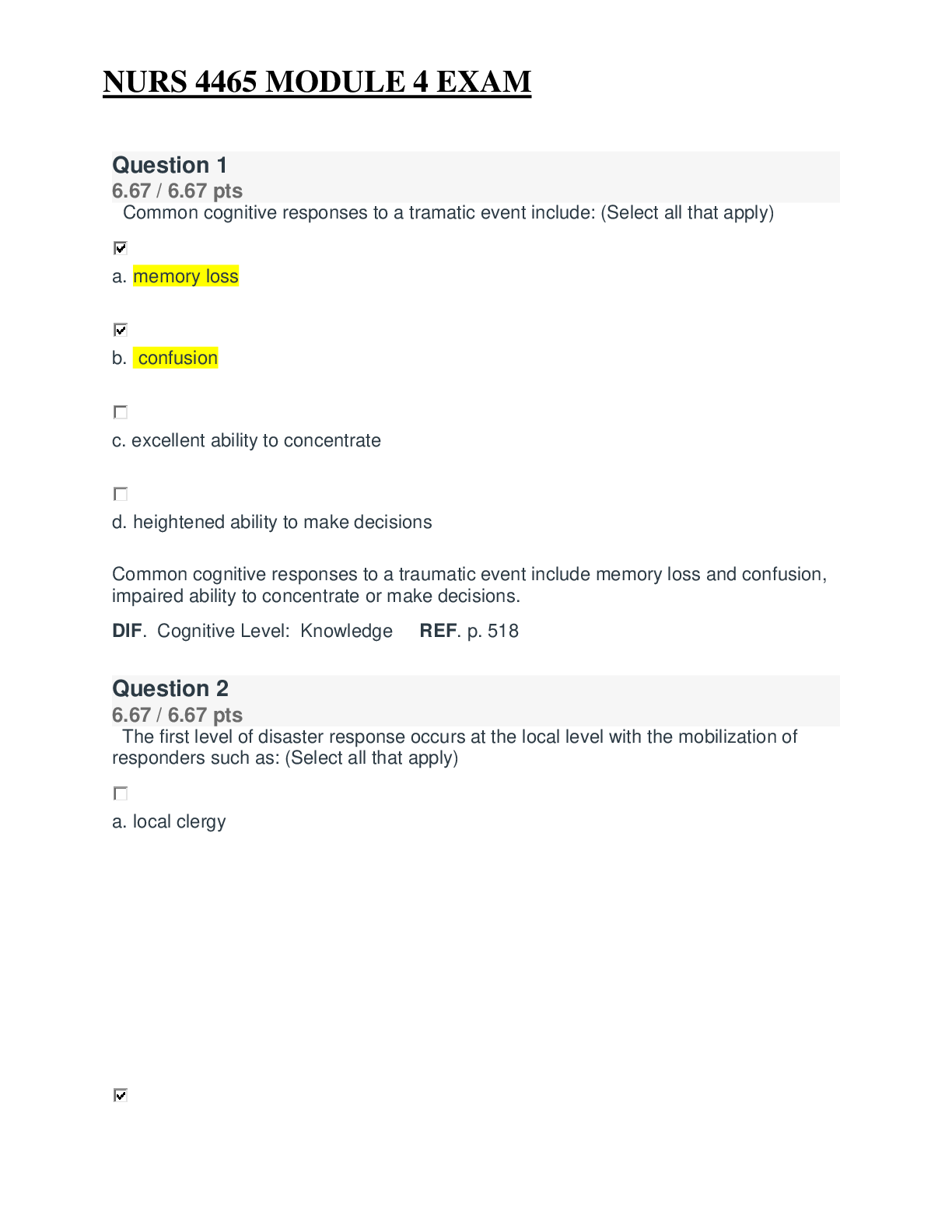Anatomy > EXAM > BIOD 151 Module 4 Exam (LATEST PAPER) Questions and Answer elaborations/ 100% correct/ Portage Learn (All)
BIOD 151 Module 4 Exam (LATEST PAPER) Questions and Answer elaborations/ 100% correct/ Portage Learning
Document Content and Description Below
BIOD 151 M4: Exam - Requires Respondus LockDown Browser + Webcam Which of the following statements is TRUE concerning the function of bones? Flat bones are long and thin, such as the ulna. Long b... ones have an irregular structure The carpals are an example of short bones. Vertebrae are an example of sesamoid bone. Which of the following statements is FALSE concerning bones? Bones are not completely smooth surfaces. A foramen is a projection for a tendon or ligament attachment. A process is an elevation found in bone. Bones are a storage site for phosphorus and calcium. Which of the following statements is FALSE about the skeletal system? A. The two main divisions of the skeletal system are: lumbar and thoracic. B. The two main divisions of the skeletal system are: axial and appendicular. C. The lumbar division of the skeleton is included in the appendicular skeleton. D. The axial skeleton includes the laryngeal skeleton. E. B. and D. are false F. A. and C are false The skull is formed by bones; the facial skeleton contains bones. 30; 10 22; 14 10; 5 15; 7 What bone is highlighted in blue (also designated by the arrow) in the figure below? (superior/internal view) Ethmoid bone Label the following bones of the skeleton from the figure below: 1: 3: 5: 7: 8: 1: Frontal bone/frontal sinuses 3: Maxilla 5: Vomer 7: Maxilla 8: Mandible Label the following vertebrae as: A= Cervical B= Thoracic C= Lumbar Label the following vertebrae as: A= Cervical B= Thoracic C= Lumbar What is the name of the foramina in the figure below? 1: 2: 3: 1: Foramen ovale 2: Carotid canal 3: External acoustic meatus Label the following bone landmarks: A: C: F: I: K: A: Head/Head of the humerus C: Lesser tubercle F: Deltoid tuberosity I: Capitulum K: Medial epicondyle Which of the following statements is TRUE about the scapula? The clavicle connects to the scapula anteriorly near the midline of the human body. The medial border of the scapula connects directly to the neck of the scapula. The subscapular fossa is located on the anterior side of the scapula. The scapula articulates with the clavicle at the neck of the scapula. Which of the following statements is TRUE about the humerus? A. The lateral epicondyle of the humerus articulates with the ulna. B. The capitulum articulates with the ulna. C. The lateral epicondyle is the prominent bone landmark of the medial side of the elbow (in anatomical position). D. The head of the humerus articulates with the scapula. E. B. and D. are true The glenohumeral joint is prone to dislocation. In your own words, (1) Describe dislocation and (2) What happens in dislocation of the glenohumeral joint? 1. Dislocation of a joint means that the bone is removed from its socket. 2. Dislocation of the shoulder occurs when the head of the humerus is removed from the glenoid cavity in any direction. Label the bones in the figure below: A: B: C: D: E: A: Trapezium B: Scaphoid C: Lunate D: Triquetral E: 5th metacarpal (must include both parts for full credit) Label the bones in the figure below: A: C: D: F: G: A: Cuboid C: Intermediate cuneiform D: Medial Cuneiform F: Navicular G: Calcaneus Yellow bone marrow: is found primarily in long bones. is found primarily in short and flat bones. is found primarily in newborns, not adults. produces red blood cells. The epiphysis of a bone: A. is found at the ends of long bones. B. contains the articular cartilage at joint articulations. C. contains the diaphysis. D. is the center length of a bone. E. both A. and B. Question 18 2 / 2 pts Spongy bone: A. forms the interior of bones. B. forms the exterior of bones. C. is heavier than spongy bone. D. contains numerous bars and plates with irregular spaces. E. both A. and D. Intramembranous ossification is the formation of from : A. a growth plate; the center of a bone. B. long bones; hyaline cartilage. C. flat bones; connective tissue. D. a primary ossification center; a cartilaginous disc. E. both A. and C. What term best describes the type of fracture pictured below? Open/compound part of the bone shaft breaks out of the skin. A patient has a diagnosis of osteoporosis. (1) In your own words, describe this diagnosis and (2) What type of bone cell would they be lacking? Explain your answer. (1) Osteoporosis is a bone tissue disease. When bone tissue degenerates faster than is replaced, the bones become weak. Brittle bones cause increased pain and are more likely to fracture. (2) They would have decreased osteoblasts which are responsible for bone repair. The bone repair would be unable to keep up with the ongoing breakdown of bone which is done by the work of osteoclasts. Your patient has back pain due to a herniated disc. (1) In your own words explain what it means to have a herniated disc. (2) As reviewed in the module, discuss one treatment option to address your patient’s pain. (1) A herniated disc is an injury to the intervertebral disc, where the center portion of the disc bulges into the vertebral foramen, causing pain. (2) Explanation of 1- Physical therapy for strengthening to support back ligaments. OR 2- Surgery to fuse two vertebrae together. Matching: Match the joint with the correct joint classification (A-F). *NOTE: Some joints may fall into more than one category. Mark all that apply. A= Fibrous, B= Cartilaginous, C= Synovial, D= Hinge, E= Ball-and-Socket, F=Saddle 1. Knee joint 2. Thumb joint 3. Shoulder joint 4. Vertebral joint 5. Cranial joints 1. Knee joint: C= Synovial, D= Hinge 2. Thumb joint: C= Synovial, F=Saddle 3. Shoulder joint: C= Synovial, E= Ball-and-Socket 4. Vertebral joint: B= Cartilaginous 5. Cranial joints: A= Fibrous Name the ligament highlighted in blue in the figure below: Anterior sacroiliac ligament Name the ligament highlighted in blue in the figure below: MCL- Medial collateral/tibial ligament Name the ligament highlighted in blue in the figure below: Acromioclavicular ligament [Show More]
Last updated: 1 year ago
Preview 1 out of 17 pages
Instant download
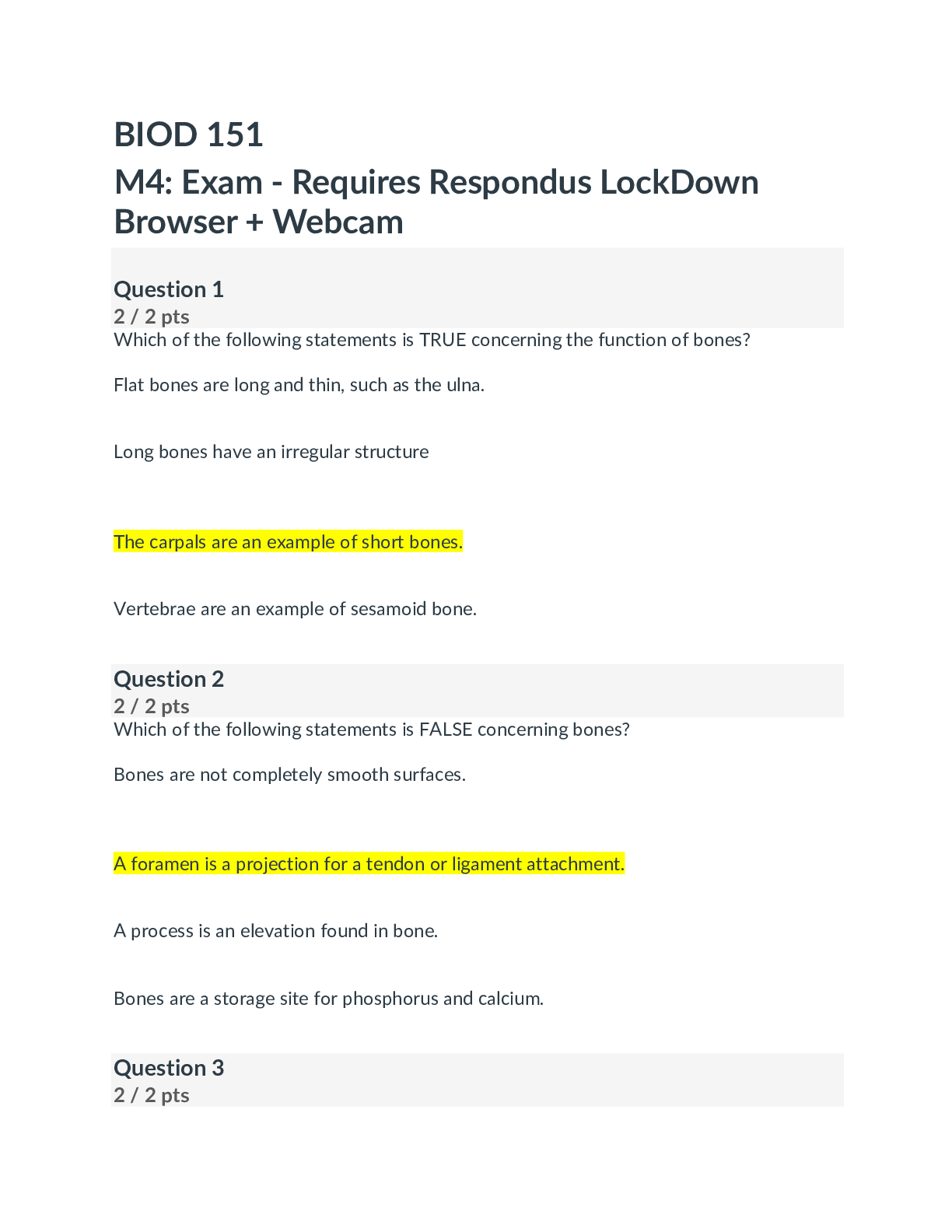
Buy this document to get the full access instantly
Instant Download Access after purchase
Add to cartInstant download
Reviews( 0 )
Document information
Connected school, study & course
About the document
Uploaded On
Sep 12, 2022
Number of pages
17
Written in
Additional information
This document has been written for:
Uploaded
Sep 12, 2022
Downloads
0
Views
46






.png)







